Meet Report: 12 October – 6 November 2018.
After a most enjoyable YRC trek across the roof of Nepal in Dolpo in the autumn of 2016, it was a tough choice of where to go next. Humla and Zanskar came to mind. However, several authors including Peter Boardman and Kev Reynolds claimed that the Kanchenjunga basecamps trek is one the most beautiful in the world. Albert Chapman had been singing its praises to me; Alan Linford, Alan Kay and Ged Campion had all been to this area and everyone was enthusiastic about how much we would enjoy it, so it became an easy choice.
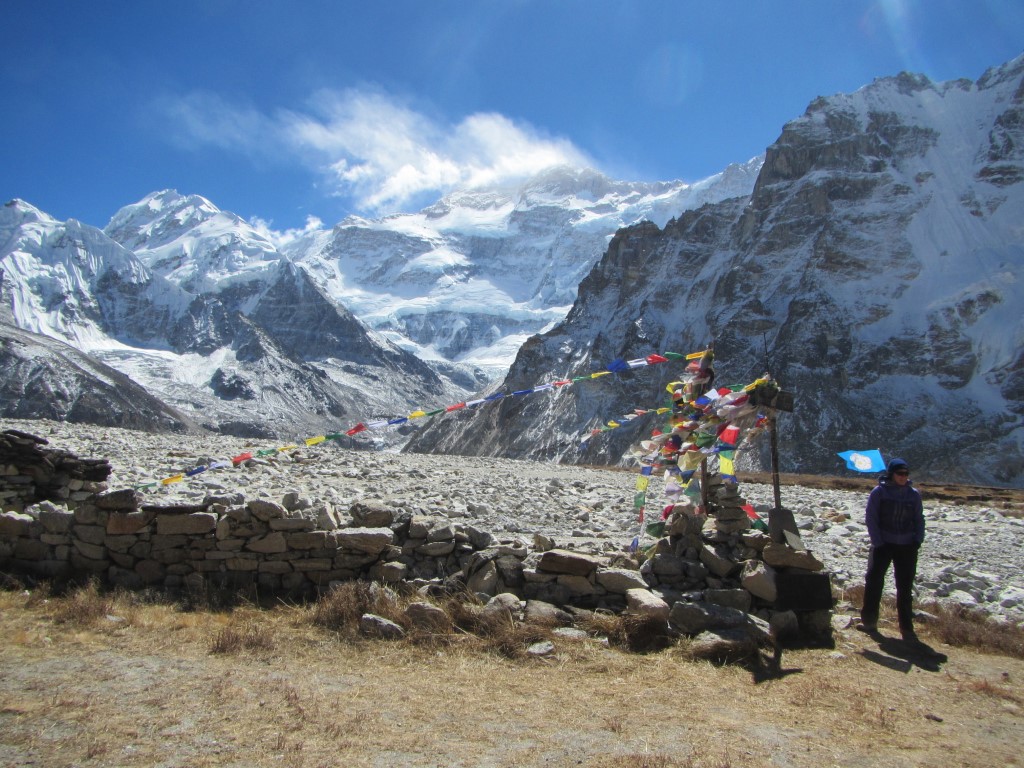
Introduction
Kanchenjunga (8,586m) is the third highest mountain in the world and rebuffed an attempt by Dyhrenfurth’s 1930 expedition from the North Base Camp (NBC). YRC member Frank Smythe was on that trip and made the first ascent of Jonsong Peak (7483m), which at the time was the highest summit ever climbed. Perhaps uniquely for a Himalayan expedition Smythe celebrated another first ascent, Nepal Peak (7154m), by drinking champagne and playing a mouth organ. Kanchenjunga was first climbed by Joe Brown and George Band in 1955 from the South Base Camp (SBC). This creates two objectives for the trekker with very different perspectives of the mountain and its surrounding peaks and glaciers from the Nepal side.
This area is also attractive because it is comparatively little visited by tourists and there are few tea houses and lodges compared to Annapurna or Khumbu. The entire district was closed to trekkers until 1989 and eastern Nepal probably sees no more than 500 trekkers at most each year undertaking the Kanchenjunga trek in whole or part.
The route ascends through five of Nepal’s climatic zones (tropical, sub-tropical, temperate, sub-alpine and alpine), allowing progression from the hot and humid lowlands of the Nepal-India border (the Terai), up through the foothills through a progression of habitats past the rice paddy terraces on cultivated hillsides and black cardamom plantations, then bamboo, rhododendron, pine and larch forests and on to the more familiar terrain higher up as the mountains and glaciers are reached.
The wooden and corrugated iron or stone houses in the villages are of course adapted to these zones with thatched roofs lower down, then tin roofs and finally simple timber planked roofs held in place with numerous rocks. The birders in our party were kept busy and there were plenty of other flora and fauna to see, including orchids, gentians, edelweiss, blue sheep, lizards, geckos, frogs, cicadas, butterflies, moths, spiders and some slippery leeches.
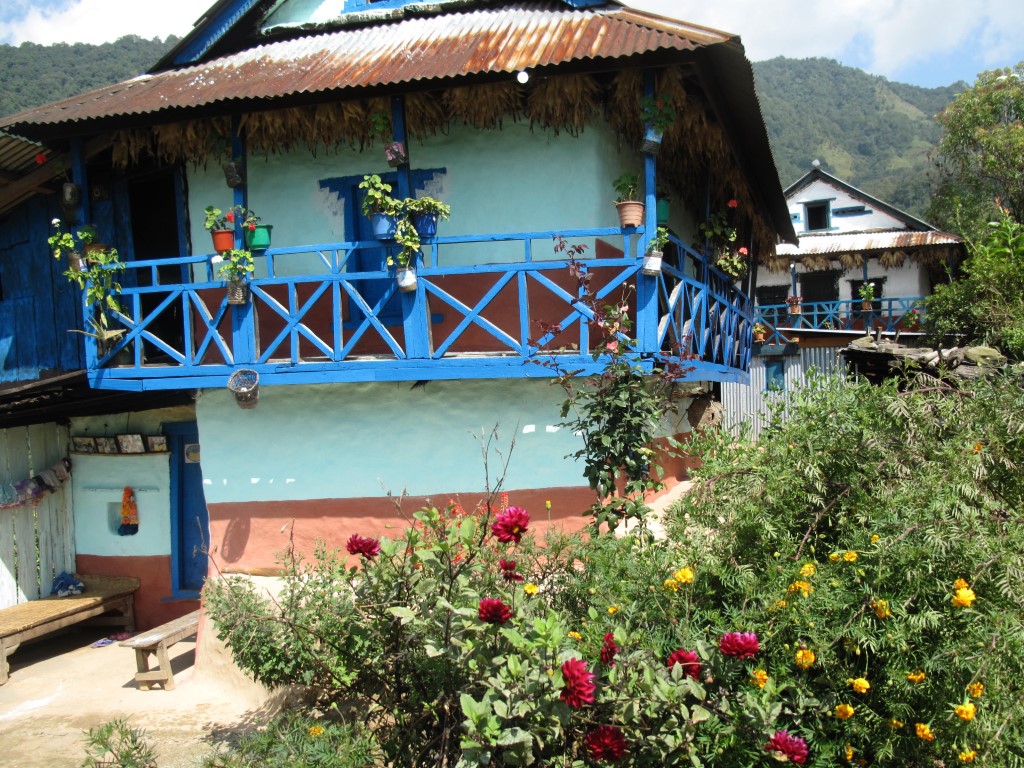
From a cultural perspective, the area has predominantly Limbu and Rai villages lower down and the trails between their settlements were dotted with poignant carved memorial stones often set in chautaara (trailside resting places often used by porters). The higher villages at Phere and Ghunsa were home to people of Tibetan extraction and were complete with Buddhist gompas, chortens and mani walls with many prayer flags in evidence.
It was clear that this post-monsoon trek was going to contrast nicely with the previous Dolpo trip and the points above led us to expect something exceptional – we were not disappointed!
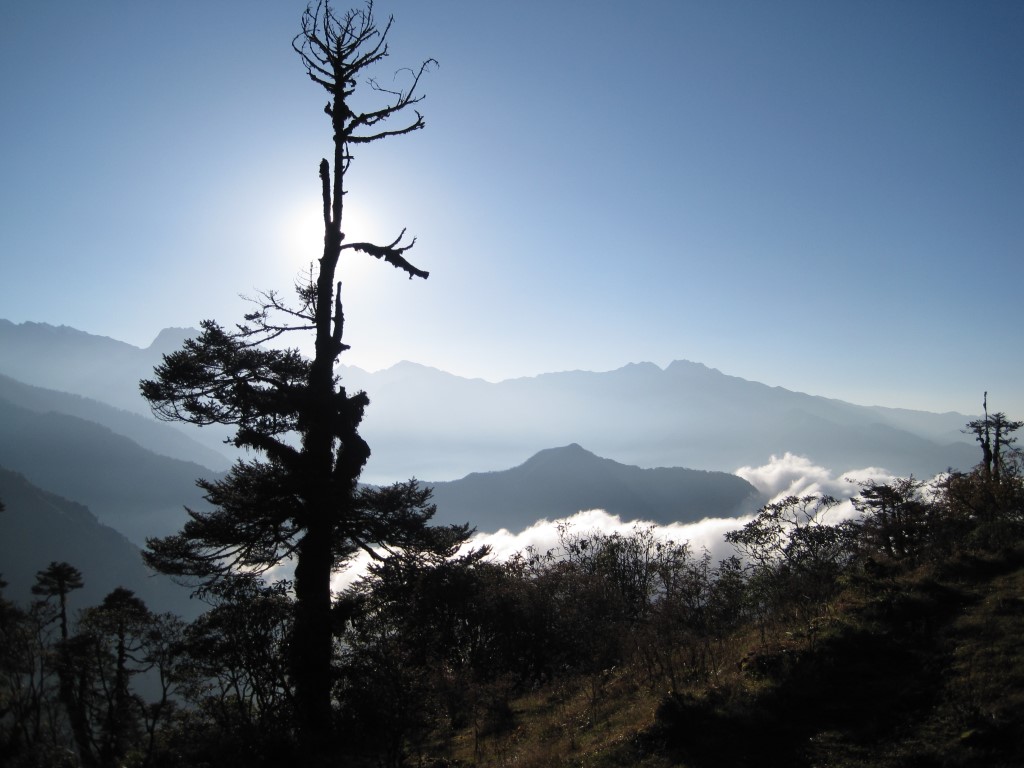
Route Summary
After flying from Kathmandu to Bhadrapur in Nepal’s south-east corner, we took jeeps up to the airstrip at Suketar above the large town of Taplejung to begin a 22-day route of some 260 km and 13,700 m ascent planned in conjunction with Rimo Expeditions. We trekked first through the settled forested foothills, with some surprisingly long and steep ascents to reach the Simbuwa Khola which was followed NE up to the Yalung glacier and the Kanchenjunga South Base Camp with its astonishing views. Then we crossed four high passes to 4646m to reach Ghunsa, the last permanently settled village in the Ghunsa Khola valley.
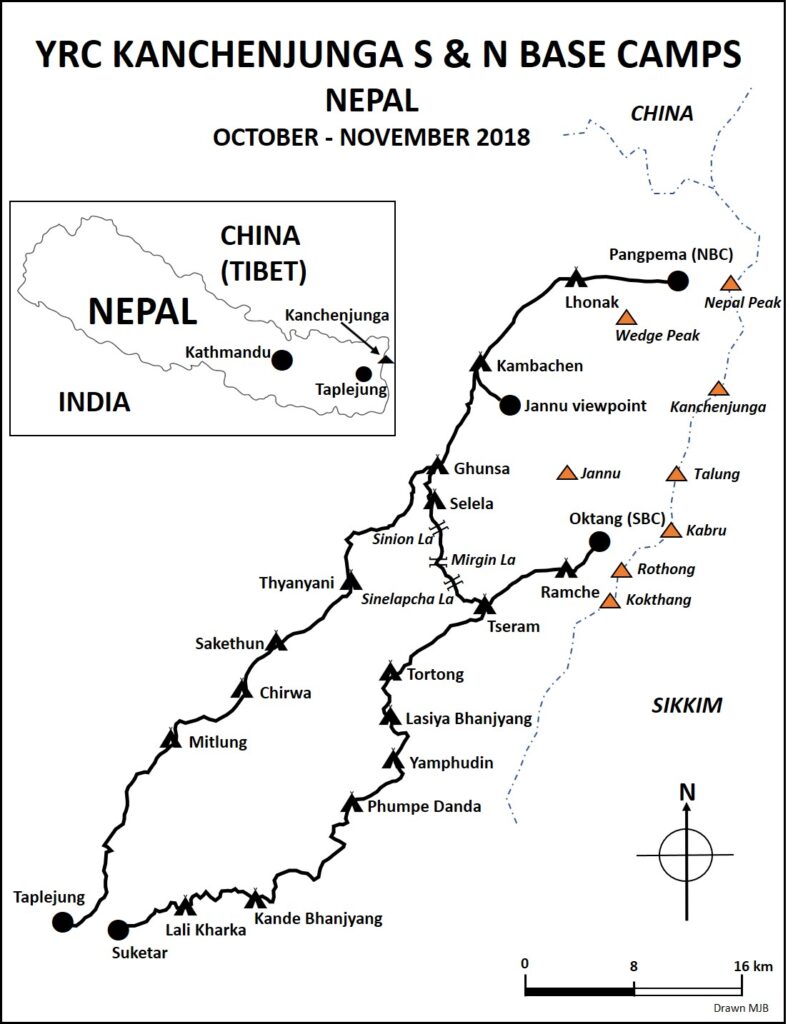
This valley was followed NE to Pangpema, the Kanchenjunga North Base Camp passing a few simple lodges and yak herders camps. From this high point, we came back to Ghunsa and our return was made SW beside the Tamor Nadi river, with a final climb from Mitlung village up to Taplejung to meet our jeeps for the return to Bhadrapur. (NB Spellings of place names taken from the Himalayan Maphouse 1:100,000 mapping).
- Oct 12: Arrive Kathmandu
- Oct 13: Fly to Bhadrapur (91m) in the Terai and drive to Phidim (1164m)
- Oct 14: Drive to Suketar (2426m) and trek to Lali Kharka (2281m)
- Oct 15: Lali Kharka to Kande Bhanjyang (2126m)
- Oct 16: Kande Bhanjyang to Phumpe Danda (1861m)
- Oct 17: Phumpe Danda to Yamphudin (2061m)
- Oct 18: Yamphudin to Lasiya Bhanjyang (3411m)
- Oct 19: Lasiya Bhanjyang to Tortong (3003m)
- Oct 20: Tortong to Tseram (3884m)
- Oct 21: Tseram to Ramche (4492m)
- Oct 22: Ramche to Oktang – SBC (4855m) and descend to Tseram
- Oct 23: Tseram to the Sinelapche La (4708m), Mirgin La I and Mirgin La II to Selela (4229m)
- Oct 24: Selela to Ghunsa (3329m)
- Oct 25: Rest day in Ghunsa
- Oct 26: Ghunsa to Kambachen (4096m)
- Oct 27: Kambachen to Lhonak (4764m)
- Oct 28: Lhonak to Pangpema – NBC (5170m) and return to Lhonak
- Oct 29: Lhonak back to Kambachen
- Oct 30: Lhonak to Jannu viewpoint (4408m) and down to Ghunsa
- Oct 31: Ghunsa to Thyanyani (2478m)
- Nov 1: Thyanyani to Sakethun (1636m)
- Nov 2: Sakethun to Chirwa (1243m)
- Nov 3: Chirwa to Mitlung (916m)
- Nov 4: Mitlung to Taplejung (1805m) and drive to Ilam (1225m)
- Nov 5: Drive to Bhadrapur airport and fly to Kathmandu
- Nov 6: Relaxing in Kathmandu
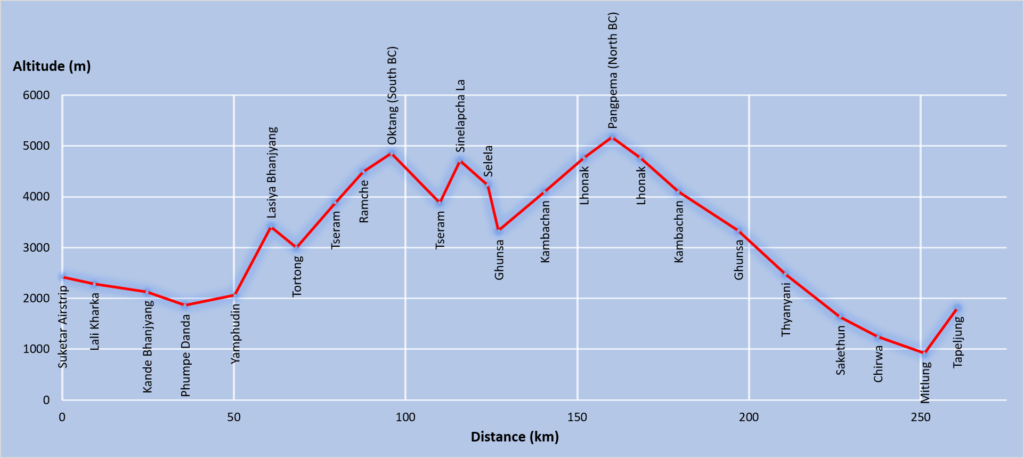
Kathmandu Valley and the Terai
Barry and Janelle, Kjetil and Ann-Karin, and Richard arrived before the main group and took in the sights of the Kathmandu valley. The rest of the UK contingent arrived later. Some got their visas after a long wait, then we met up with Motup and Raj Kumar, our Rimo guide, met us at Kathmandu Airport and we were soon whisked off to the calm oasis of the Kathmandu Guest House hotel to join the others. Over a beer and a curry, we discussed the plans for the trek.
With our original plan to fly directly from Kathmandu to Suketar in tatters as Yeti Airlines had discontinued their charter service (probably because operating extra flights to Lukla was more profitable), we had to fly to Bhadrapur in the Terai lowlands and take a jeep over the foothills to Suketar. At the end of the trek, we would have to reverse this journey.
The next day, all internal flights were delayed due to a backlog of flights out of Lukla, but we eventually took off. The views of Everest and the many other snow-capped giants was spectacular as we flew along the Himalayas and after half an hour, touched down in Bhadrapur.
Our kit was loaded into three jeeps and we headed for the hills. The road was tarmacked and comprised of an endless series of switchbacks as we climbed up and down spurs and crossed bridges, rivers and watersheds into the foothills. On the way, we saw rhesus monkeys playing beside the road. We stopped for a pleasant thali lunch and drove past the tea plantations at Ilam, then a gruelling five hours later, stopped for a night in a hotel in the town of Phidim. Becca celebrated her birthday here with a cake and we enjoyed our last beers for some time.
Suketar to Kanchenjunga South Base Camp
Next morning, an early start and another three hours in the jeeps, stopping only to photograph our first hazy view of Jannu and Kanchenjunga in the distance, brought us to Suketar where the rest of the Rimo crew and some porters awaited.
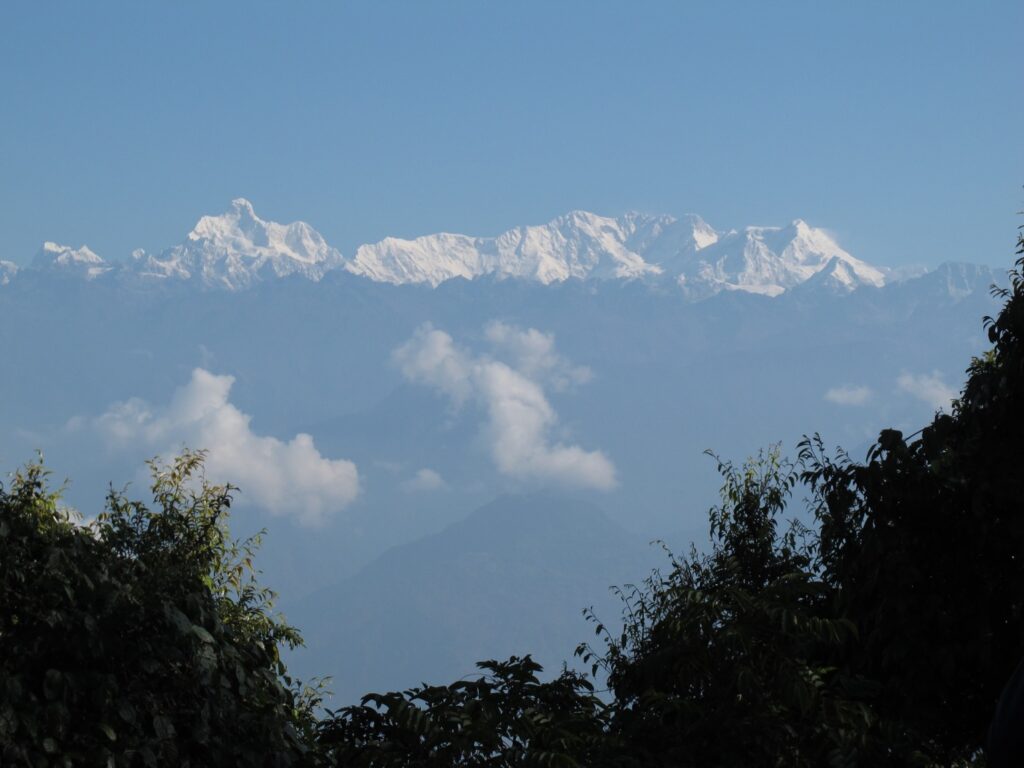
There were no mules on this trip and we were going to be relying on porters for the heavy lifting with over 1000kg to transport. Rimo had brought a team of 20 porters from a village in the Kathmandu valley, tried and tested numerous times before. Under the leadership of Kulparsad, the head porter (sirdar), they were entrusted with our kit bags. They were augmented by a second team of 15 local porters from Taplejung engaged to carry the food supplies and they were paid off in groups part way as we progressed, and literally ate through their loads.
Niri, our excellent and ever-cheerful cook from both the Mera and Dolpo trips was with us, this time with a nine-strong kitchen crew. They had prepared lunch for us, which we ate in the sunshine while the Kathmandu porters played weighing games with our kit bags to get equitable loads sorted out.
After lunch we started with a gentle three hour walk along a track down to our orange-tented camp at Lali Kharka, a high pasture with a lovely open view and we relaxed with afternoon tea in the sun. Just before dinner, Motup got out his transcutaneous pO2 meter to record our baseline oxygen saturation levels, so he could monitor how we were acclimatising each day in the coming weeks. Dinner was excellent and Niri’s chicken curry that evening was the equal of any UK restaurant.
Like most mornings, we had a 6-7-8 strategy. For the uninitiated, this means tea delivered to the tent at 6am, followed by a bowl of warm washing water five minutes later, then kit bags packed for breakfast at 7am and set off walking by 8am. We started with a long downhill section into aspidistra-like black cardamom plantations and stopped to talk to two men who were extracting the highly valuable pods for drying and export to India. We crossed over the Phawa Khola on our first suspension bridge, and had lunch followed by a long steep ascent up a pitched path with plenty of chautaara resting places. Many were inset with Hindu memorial stones inscribed in Nepali or Limbu script with carvings of the sun, moon, a trident, fish and elephants – many were carefully coloured. This climb led to the Kande Bhanjyang col and our second camp. Before dinner our pO2 levels were recorded again.


Off at 07:45, we had another down and up day, passing a 100m ribbon waterfall and a lovely section of jungle but no grey langur monkeys were seen. We stopped for lunch by our first chorten, perched on a col with great views. Then down past colourful houses, some thatched, with goats, cows and water buffalo in mangers with free-ranging chickens everywhere, followed by another uphill section to Phumphe Danda camp on a ridge, with fine views up the Kabeli Khola valley. Niri produced a large tray of his famous pakora which we wolfed down with our tea.
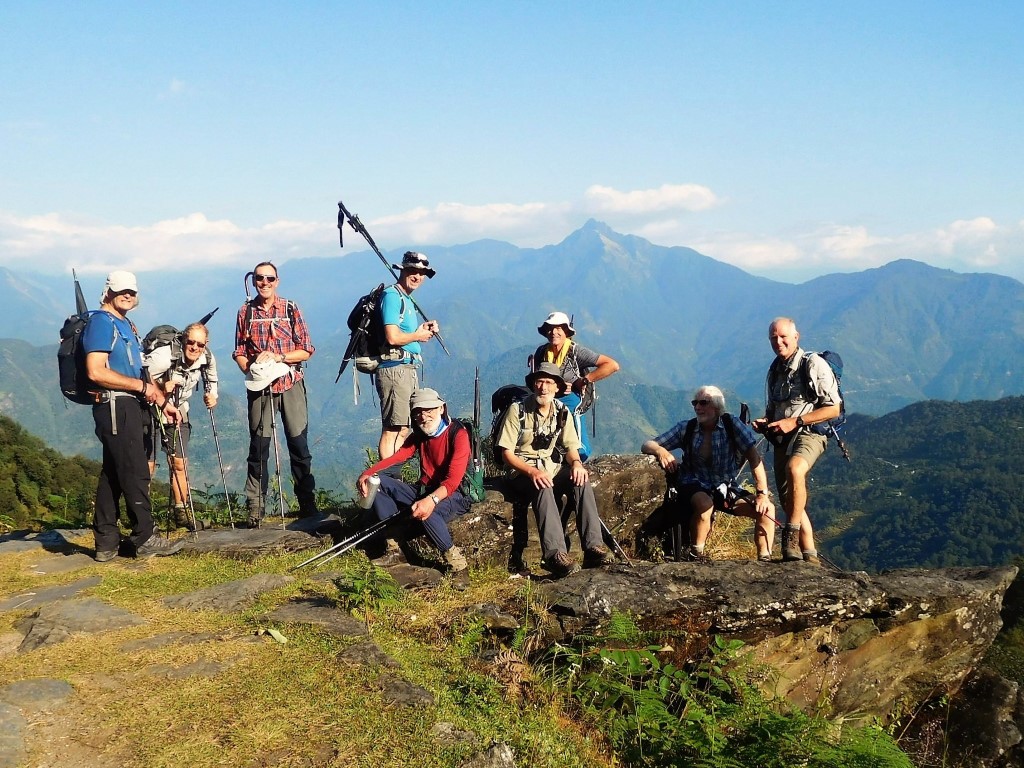
Leaving our camp in sunshine the next day, we passed through the village of Mamanke on a well-flagged trail, resplendent with marigolds and poinsettia trees. Many of the houses had buzzing bee hives made from sections of hollowed-out tree trunks suspended from their eaves. The path went down over a couple more suspension bridges. The main route had been affected by a major landslide and was unsafe, so we climbed up by a much thinner footpath. Undulating became our watchword as yet more steep terrain was crossed and eventually, we arrived in the Yamphudin hamlet for tea and biscuits after a tough day. Our camp was shared with a French group going up and a returning German party enthused with the views from SBC.
We were given packed lunches by Niri as another energetic day was in prospect. More “undulating” trail dotted with pink and red orchids led to couple of bridged river crossings, then a long steep climb up through the forest with many rocky steps eventually led to our camp at the Lasiya Bhanjyang col, where the mist drew in shortly after our arrival. The mugs of hot lemon, cheese and crackers were very welcome. The leeches that appeared in our tents were not! We spared a thought for the kitchen porters who had to descend for 15 minutes to the nearest water source with plastic jerry cans and then spend 30 minutes hauling them back to camp in the drizzle.
We awoke to a lovely bright clear morning with stunning views of Jannu behind back-lit trees which kept the photographers happy. After breakfasting on cornflakes, pancakes and omelette, we set off to traverse round the head of a massive landslip area on the other side of the col. A thin trail led down through old rhododendron cloud forest with Spanish moss draping branches and ferns growing in the damp conditions underneath. Lower down in the wood was a clearing with a rough dwelling where a boy outside, who attended Yamphudin primary school, was busy doing his Grade 5 English lessons, while his father churned milk with a wooden paddle. More forest trail led to our camp at Tortong.
Blue skies were again overhead as we left camp and entered an ancient Tolkienesque wildwood on the north bank of the Simbuwa Khola. We progressed steadily upwards through moss covered boulders and past tree trunks of massive old pines and rhododendrons with little undergrowth, crossing several clearings with graziers’ huts, stopping at one for lunch. We passed the prayer flagged Buddhist shrine marking the trail junction with our later route over the Sinelapcha La. The terrain then became more open as we reached the roomy camp at Tseram. Niri served us an excellent dinner: mushroom and garlic soup with popcorn; cheese, mushroom, tomato and herb pizza, potato and cheese stuffed marrow and French beans; finishing up with mango slices and mugs of hot chocolate.
Fortified with porridge, chapatis and eggs, we left our icy tents to thaw in the sun and walked steadily up beside the Simbuwa Khola drawn by the wonderful views of snow-capped Rathong (6682m) and the four Kabru summits (7412m) behind the Yalung glacier. The views just got better and better as we ascended and entered the ablation valley (the subsidiary valley formed between the crest of a lateral moraine and the valley side) which we followed to our spectacular camp at Ramche in time for lunch. The afternoon was spent pottering about the camp under warm sunny skies and we climbed up to the fluttering prayer flags adorning the moraine crest above the tents to admire the magnificent mountain view of six and seven thousand metre peaks from Koktang to Rothong to Kabru I-IV round to Talung.
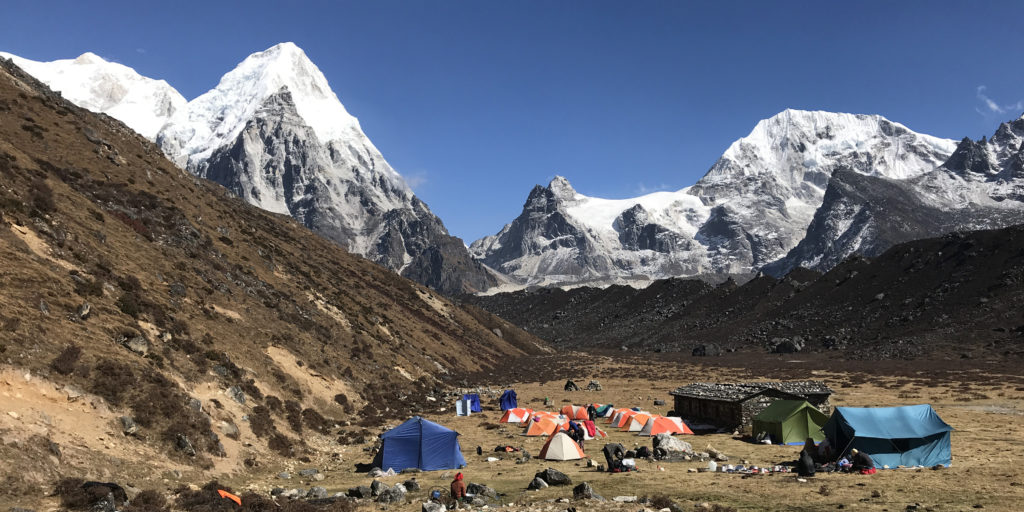
We awoke to yet another bright and cold but windless morning for our walk up to Oktang, close to Kanchenjunga South Base Camp. After a substantial breakfast, we continued up the ablation valley path, then onto the lateral moraine of the Yalung glacier and onto the large chorten with its tridents, bells, oil bowls and the ashes of juniper fires, beneath lines of fluttering prayer flags. The views of Kanchenjunga under blue skies were superb – Michael and Motup pointed out the modern line of ascent and its variants. Several of us continued towards Corner Camp for even better views as recommended by Alan Kay, but a large unstable landslide soon prevented any further progress. We also saw a herd of blue sheep grazing on the slopes above. We returned to Ramche for lunch and retraced our steps back to the Tseram camp to complete a most memorable days trekking.
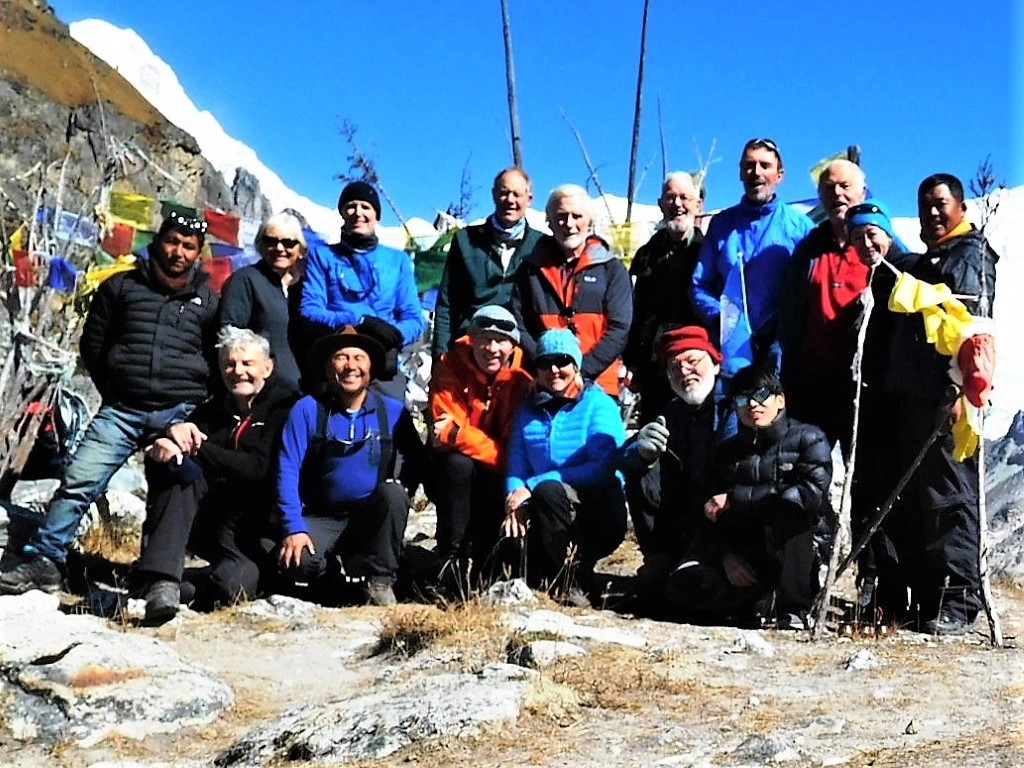
Kanchenjunga South Base Camp to Kanchenjunga North Base Camp
The next day was the crux: our crossing over the triple high passes. This merited a very early start, so we breakfasted well at 5.45 and were off 45 minutes later armed with packed lunches. We walked back down to the Buddhist shrine and said our silent prayers as we took the path up the mountainside towards the Sinelapcha pass. Once we were above the treeline and in the sunshine, the stunning views of Rothong, Kabru and Kanchenjunga soon took our minds off the climb. A couple of tranquil tarns were passed as we steadily gained height and soon the prayer-flagged Sinelapcha La was underfoot.
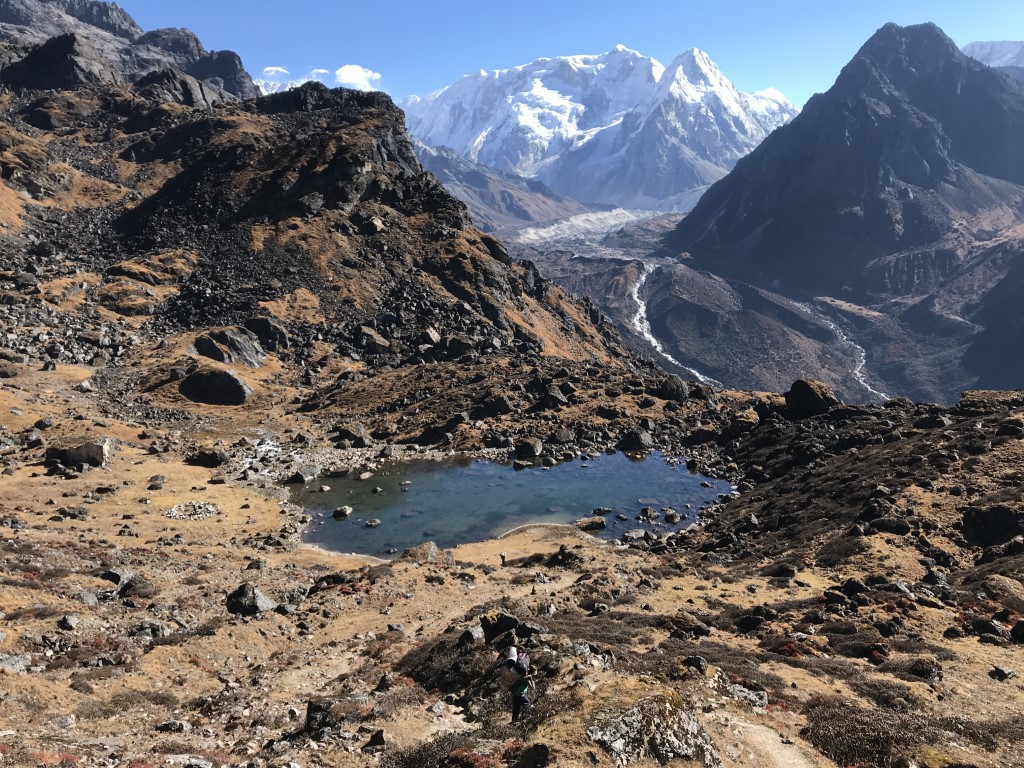
A long more-or-less contouring path took us across to the Mirgin La with its remarkably life-like sentinel cat, surveying some very spiky rock peaks. A pair of yaks with two drivers passed us on the trail. Lunch was taken below an icicle festooned crag with alpine accentors flitting around. The path continued up and over to the third pass, the Sinion La, and then down to our camp at Selela. Unusually this was sited at the confluence of two large streams and was reached by a set of stepping stones. After a long hail shower had abated, we recuperated with cheese and biscuits with our tea in the dining tent and rested before dinner.
After a cold night, we ate a late breakfast in the sunshine. An easier day was in prospect as we took a long contouring path across to the Sele La, really just a notch on a ridge, and then steeply down the other side through the rhododendron woods to the top of a prayer flagged spur and down to Ghunsa, the last permanently settled village in the valley for lunch in the lodge dining room. Mick walked down the hill with Austrian author Dr Dieter Höss and his wife Ena. They discussed his recent book describing his enviable tally of 28 Nepali treks mostly in less-visited areas in the context of the people he met and photographed. Later he and his wife joined us for afternoon tea. We all enjoyed fresh yak burgers with roast potatoes and pasta for dinner.
We decided to take our rest day in Ghunsa rather than higher up at Kambachen as originally planned, since Becca’s cold and cough had worsened and developed into a chest infection needing antibiotics. David and Nick were also nursing severe colds and coughs.
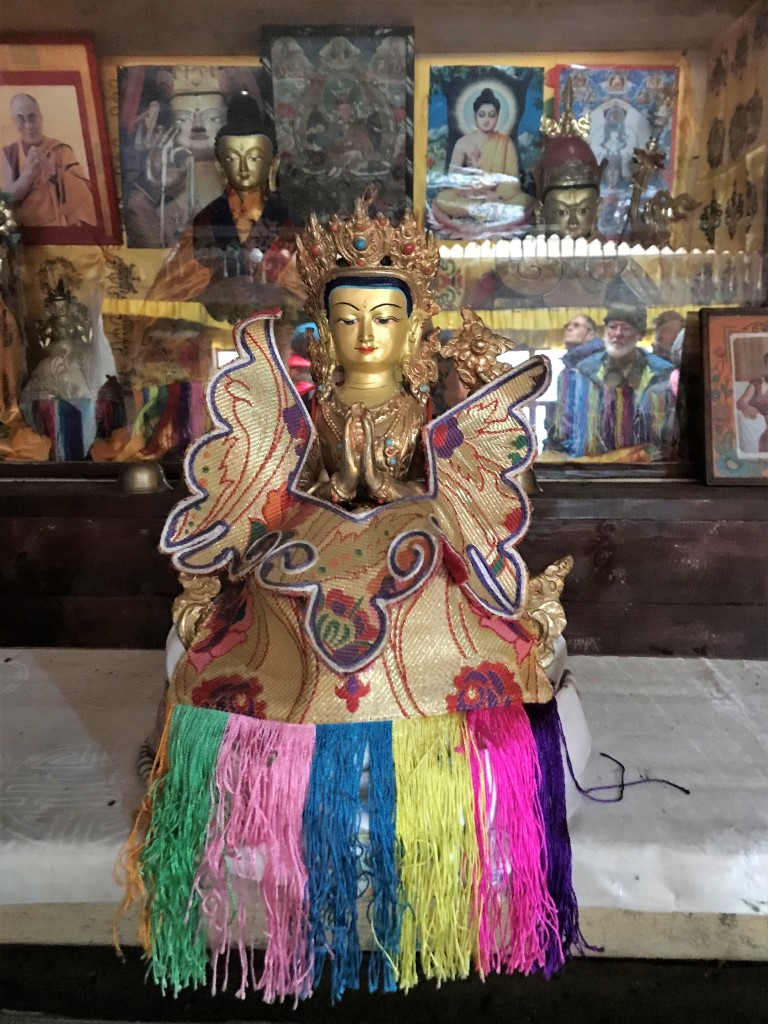
After breakfast, we sauntered across either the new suspension bridge or the older cantilever bridge across the Ghunsa Khola to visit the Tashi Choeling Gompa. This Buddhist monastery is one of the oldest and most significant gompas in Eastern Nepal. The monastery and its lamas belong to the Nying-ma-pa (Red Hat) sect of Tibetan Buddhism and the Rimpoche originally came from Chabuk, just to the north of the Tibetan border, but fled to Ghunsa after the Chinese invasion. We inspected the rows of colourful silk-wrapped prayer books and admired old thankas (Buddhist paintings) and the many statues of deities behind the altar. Outside we saw the much smaller “old gompa” perched on top of a huge boulder and propped up by tree trunks. Three ancient prayer wheels encased in stitched animal skins were turned for good fortune.
The rest of the day was spent relaxing or exploring this interesting village. Most houses were timber, some built on low stone walls in plots with wooden palings. Most had simple planked roofs held in place by rows of large stones with the odd satellite dish peeking out. We watched a couple of ladies in traditional dress building a potato clamp to protect their seed crop over-winter. The potatoes were tipped into a deep hole and were covered in turn by juniper branches to keep the animals away, turfs, a layer of soil, a sheet of polythene, then all topped off with a pile of small logs. Postcards were bought at the Post Office and posted home in the “Latter Box” outside. We also visited the newly built hospital and were shown round by the Health Officer, who explained that a lot of his work was involved with child birth. The day was rounded off by a celebration of Barry’s birthday and the consumption of another of Niri’s chocolate cakes with a tot of whisky.
After a day’s rest, and pO2 checks, all were feeling ready to head towards NBC. Having had a good breakfast, we set off along the frosty track beside the Ghunsa Khola and into the larch woods, their frosted needles glowing gold in the warm sun. The path was a delight and after flirting with the river bed, eventually led up past a kharka to a huge shelter stone where we had lunch. We then climbed up the old terminal moraine of the Jannu glacier to be greeted by an astonishing view of Jannu itself and its snowy neighbours behind lengths of coloured prayer flags silhouetted against the blue sky. A wobbly bridge over the river was safely crossed leading us into the summer grazing settlement of Kambachen, beautifully situated in a wide glen at a river confluence. We camped outside a lodge and ate in its draughty dining room warmed by an efficient yak dung stove.
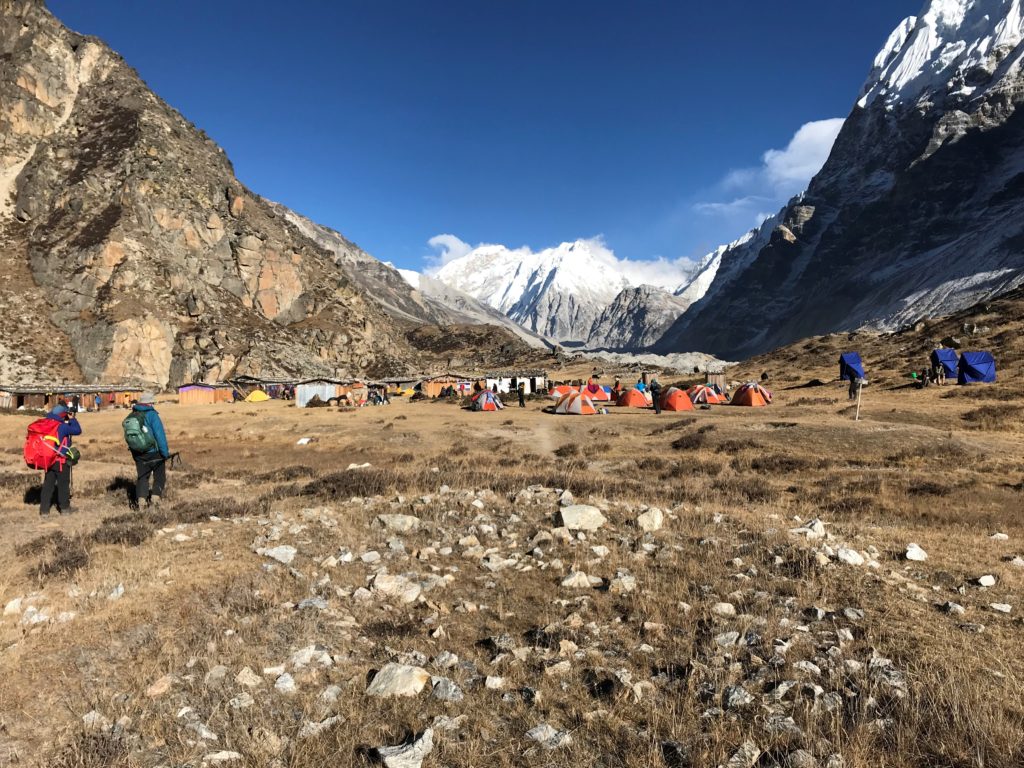
The next day took us up to Lhonak, our final high camp. The trail was comparatively gentle as we passed an icy waterfall into more barren terrain that led to Ramtang Kharka where a large herd of yaks and their calves were grazing. Niri was cooking lunch in one of the crude tents while the owner was serving noodle soup and tea prepared over an open fire to a few other trekkers and their porters. The other tent was used by the yak herders as a dairy and they were milking yaks into a leather bucket outside. The magnificent mountain views developed further to include Gimmigela and Wedge Peak (Chang Himal) as we reached camp, again adjacent to a lodge, but this time with a less draughty dining room. Its stove was welcome as it was -10°C inside our tents when we retired to our sleeping bags at 8pm.
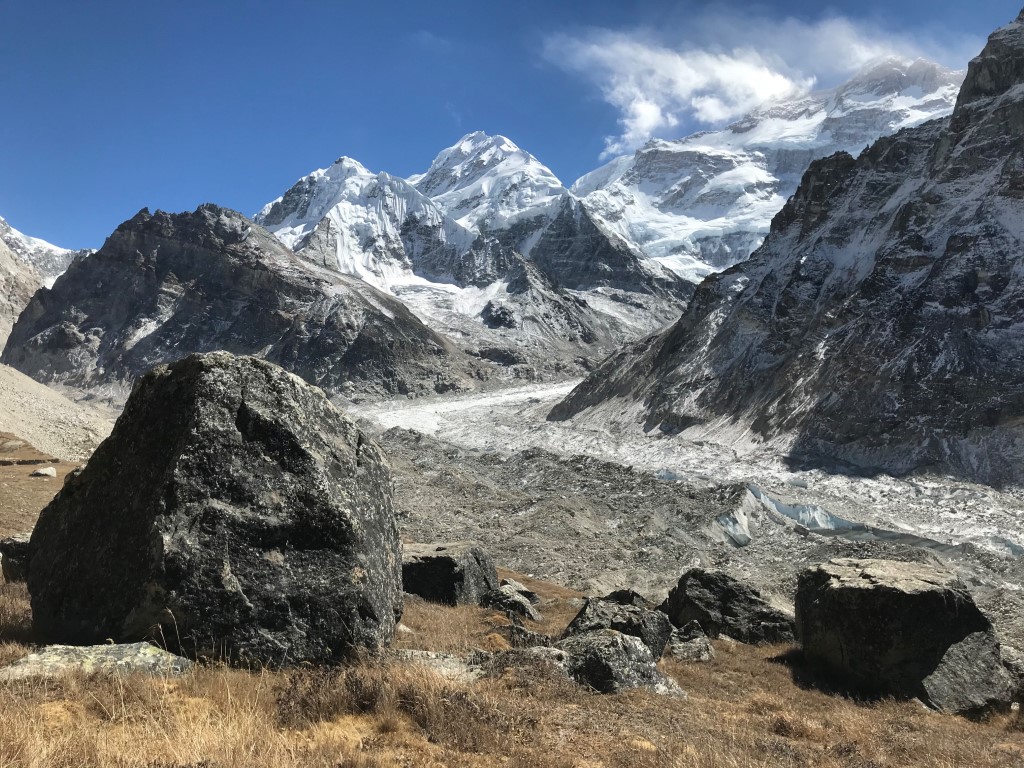
It was another glorious sunny day for our excursion up towards Pangpema and NBC. We crossed frozen grassland then climbed across a boulder field and up to traverse three new landslides and back down to the path alongside the moraine of the rubble-strewn ice of the Kanchenjunga glacier. A couple of monstrous boulders were passed, and a final easy landslip negotiated to reach the small lodge at Pangpema with its fine view of the towering north-west face of Kanchenjunga. A return was made down-valley back to Lhonak for the night.
Kanchenjunga North Base Camp to Taplejung
From Lhonak, we retraced our steps to Kambachen in the warming sunshine, pausing to watch the extrication of a train of mules crossing the snow bridge below the waterfall where they had sunk up to their bellies. We spotted a lammergeier soaring above us as we neared camp. A couple of us walked up to the nearby Jannu viewpoint and got some good photos and a superb birds-eye view of the campsite.
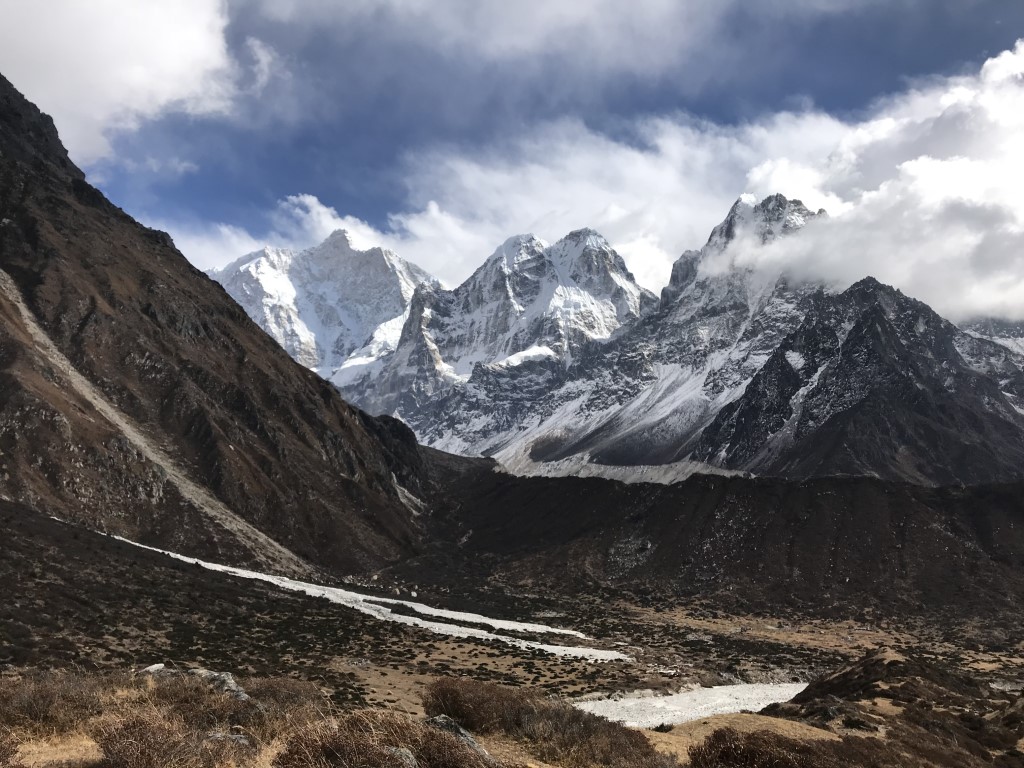
The next day we made a short excursion up the moraine to a closer viewpoint of Jannu on the way to its Base Camp, returning the same way and then back down the trail through the lovely larch woods to Ghunsa. After we’d had a good wash, Niri served tea and another chocolate cake. Another splendid pizza dinner followed in the warm dining room – sips of our duty-free whisky adding further warmth.
Yet another sunny day saw us leave frosty Ghunsa by an excellent riverside path that led past the gompa through more golden larches to the delightful village of Phere. We passed a water-driven prayer mill at its entrance and a huge chorten on top of a massive rock, but didn’t visit its gompa. Plenty of grazing yaks were in evidence in the surrounding fields before we descended into the bamboo forest on an “undulating” trail crossing several tributary streams on new bridges.
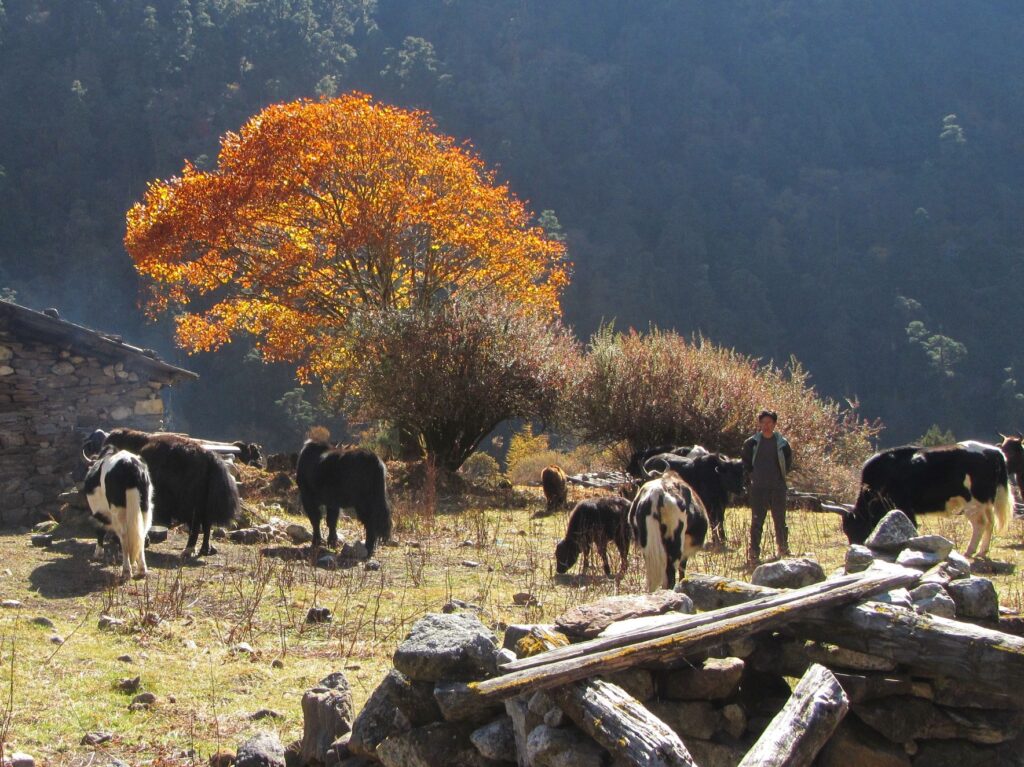
We stopped for lunch in Gyabla with good views down the Ghunsa Khola gorge. Several waterfalls were passed as we dropped into the valley to a riverside path, finally climbing up to camp in a field by a simple lodge at Thyanyani.
In the morning John was interviewed about his Cape to Cape trek by a young lady recording it on her smart phone. She had won a competition to publicise solo trekking for Nepalis: her motto was “If we can do it, you can do it!” After this we broke camp and tackled our day’s ration of undulations. We met a fit 74-year old Tibetan lady out for a walk by herself on the trail – she told Motup that she had two daughters, both working in the US. Having crossed high above the steep canyon below, the trail then dropped steeply to the floor of the river gorge and along a flood-prone path past some ribbon waterfalls. Finally, a short climb led us to camp outside an immaculately kept lodge called the Panda Guest House at Sakethun run by a friendly Sherpa family. Niri’s apple and cinnamon pie with its latticed pastry top drew admiring gasps from all except from Mick, who was tasked by Motup to cut it into thirteen pieces.
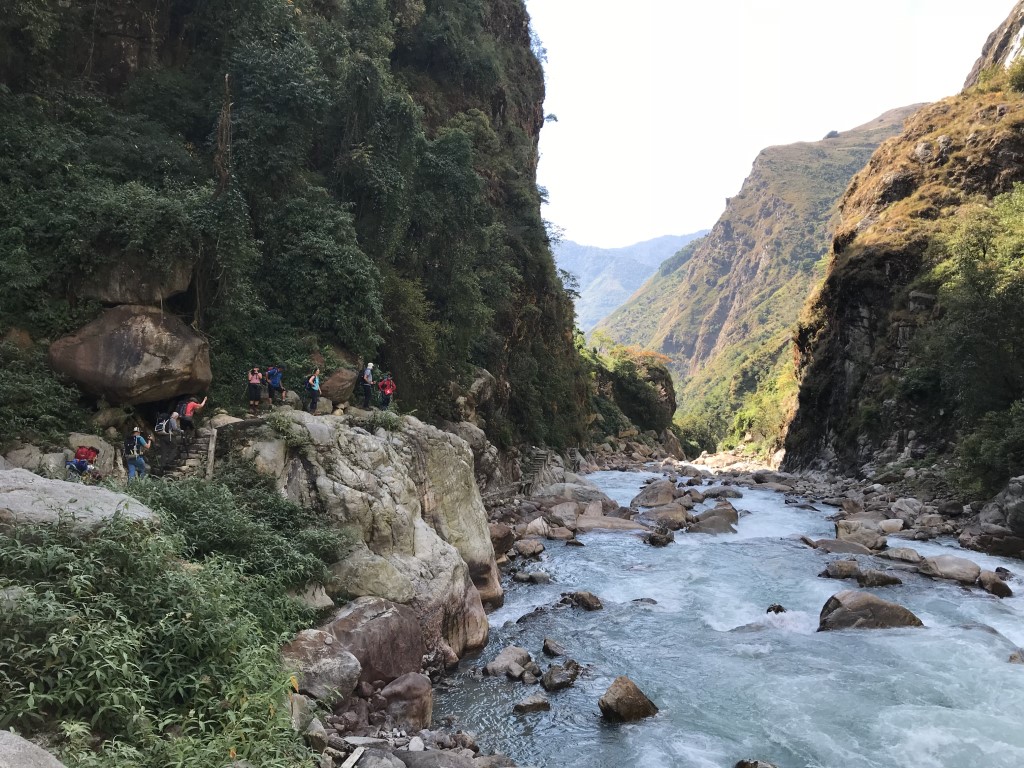
An easier half-day followed the river down-valley, now merged with the larger Tamor Nadi. We passed through irrigated cardamom plantations and then onto the first section of road we’d seen since Lali Kharka, before reverting to the old trail. Several suspension bridges crossed tributaries, then the main river itself. Under the last one we saw a fisherman inspecting his traps beside a large rock in the water. A short walk took us to the large campground at Chirwa between rice paddy fields and the river.
There was an old road, now disused by vehicles because of insurmountable landslip problems between Chirwa and Sirwa. This afforded good progress with few “undulations”. We reached the prosperous linear village of Sirwa which was connected to Taplejung by a rough road and had volleyball and football pitches, a tailor, a jeweller and numerous shops.
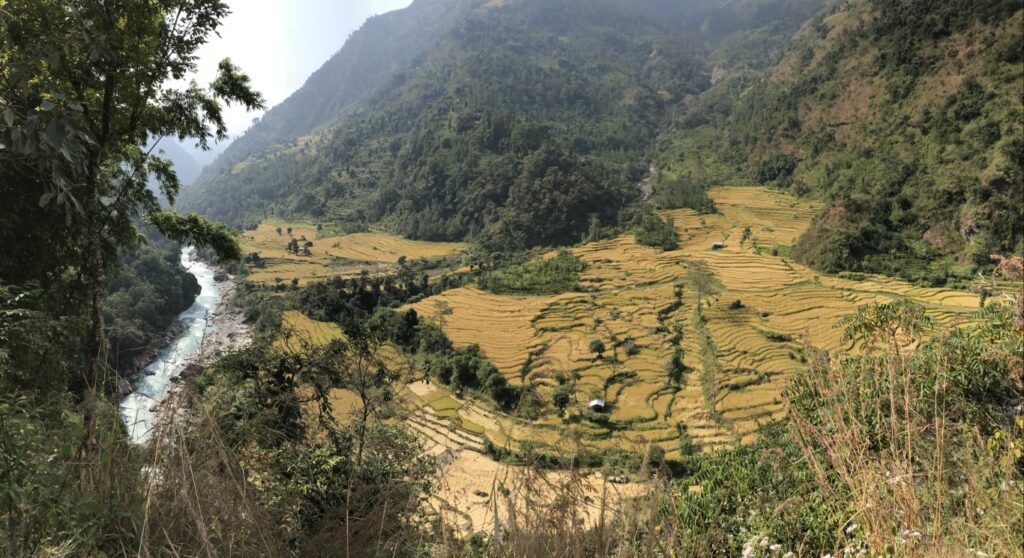
We camped in the next village of Mitlung in a cramped area outside a lodge. Our last night under canvas was celebrated with a veritable feast from Niri and his team, finished with a slice of his splendid celebration chocolate cake which he had iced with “Happy Nice Trek Ending YRC” washed down with beers and flasks of the local tongba – fermented millet beer, drunk warm through a metal straw. Bob and Richard were so enthused by the tongba, they went partying with the locals in the village and had some more!
The last day of the trek took us along the road from Mitlung, then left it to climb steeply up the old trail passing many houses and hamlets to the village of Handewa to reach the road leading into the thronging market town of Taplejung to rendezvous with our jeep drivers. After the last of Niri’s lunches we gathered together to say goodbye to our valiant porters and the ever-working kitchen crew and Sherpa team. Mick thanked them individually and presented our gifts of appreciation to all. Then we got into the jeeps accompanied by Motup and Raj Kumar and began the undulating switchback ride down to Ilam, arriving during a live rock concert.
We started early from Ilam and breakfasted on the way to Bhadrapur to arrive in good time for our return flight to Kathmandu and transferred back to the hotel. A long hot shower never felt so good! John’s mother had sadly passed away at the ripe old age of 104 while we were away and so he caught an earlier flight to get back in time for the funeral preparations.
Some spent the following day visiting some of the sights in the Kathmandu valley with Raj Kumar such as the spice market and Swayambhunath, the Buddhist temple, while others went their own way in the city shopping and visited other monuments. We all gathered in the evening for our final group dinner which Motup had booked in the opulent Ghar-e-Kabab restaurant in the Hotel Annapurna, consistently rated as the best Indian restaurant in Kathmandu. We enjoyed a superb meal – a fitting end to a fabulous trek.
We were fortunate with the post-monsoon weather. The typical daily cycle began with early clear skies and rapid warming in the sunshine, then increasing cloud build-up during the afternoon followed by clearing evenings and clear starlit nights i.e. perfect for trekking.
Acknowledgements
We are very grateful to Motup, Durga, Yangdu and Alka at Rimo Expeditions for help with planning and logistics. Especial thanks must go to our guide Raj Kumar and his team of four Sherpas: Ram, Sagar, Samgal and Pasang for their route finding, general help and support. Sincere thanks also go to our tireless kitchen crew: cook Niri and his team Saurya, Nima, Milan, Shakti, Ratna, Juman, Prakash, Bhoj and Dinman for the consistently excellent appetising and healthy food on our trek.
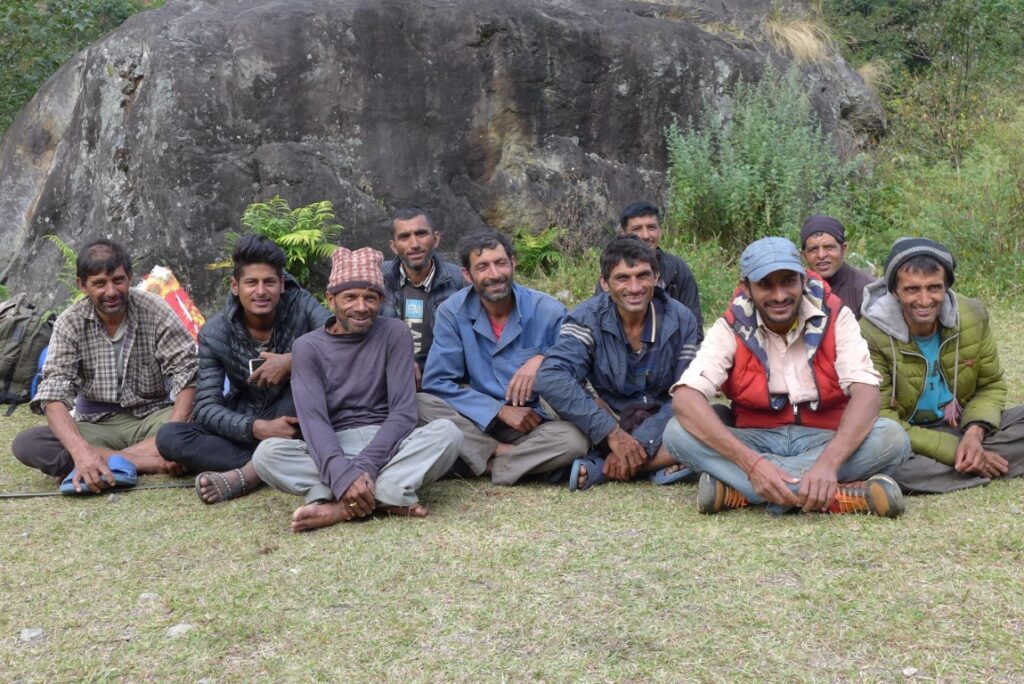
Most of all, we have to thank each one of our porters and Kulparsad, their sirdar. Without them we would simply have had a camping holiday at Suketar. They carried very heavy loads which we could only dream about on their tump lines almost every day for three weeks and only through their unstinting hard work was our trek made possible.
Participants
Mick Borroff (co-leader), Motup Goba (co-leader), Barry Dover, David Hick, Janelle Humphreys (guest), Rebecca Humphreys, Bob Peckham, Michael Smith, John Sutcliffe, Richard Taylor, Kjetil Tveranger, Ann-Karin Tveranger (guest) and Nick Welch.
Recommended Reading
Kangchenjunga: A Trekkers Guide. Kev Reynolds. Cicerone 1999.
Kangchenjunga: North and South Base Camps. Kev Reynolds. In: Trekking in the Himalaya. Ed. Kev Reynolds. Cicerone 2013.
Map: Kanchenjunga – Pathibhara and Limbu Cultural Trail 1:100,000, Himalayan MapHouse, 2009.
Trekking and Climbing in Nepal – 25 Adventure Treks in the Mighty Himalaya. Steve Razzetti. New Holland Publishers, 2000.
Trekking in the Nepal Himalaya. Lonely Planet. 2016.
The Kangchenjunga Adventure. Frank Smythe. Victor Gollanz, London. 1930.
Kangchenjunga. John Tucker. Elek Boks, London 1955.
Leave a Reply